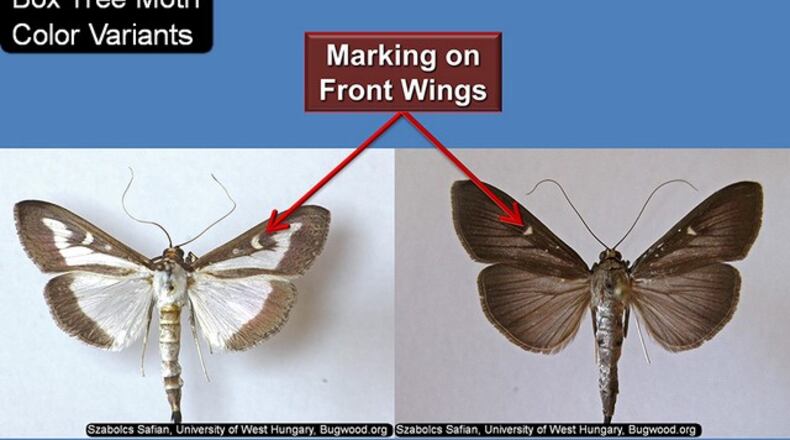The adult moths have either light-colored wings (more common) or dark colored wings. When wings are held backward, the light-colored moth has what looks like a whitish triangle in the center. A distinctive marking is the clearly visible two white dots on the top wing.
Box tree moth adults are attracted to lights, just like other moths. Check your porch lights at night and look for the adults. Keep in mind there are lots of moths and they all can appear the same. Be sure to correctly identify first.
The adults lay eggs on boxwoods (and a few other landscape plants such as Euonymous) and caterpillars hatch and consume boxwood leaves. Unfortunately, they can have up to five generations per season, however, three is more common.
The caterpillars may be easier to identify than the moth. They are the only caterpillar that we have that defoliates a boxwood completely. They are green to greenish yellow with black stripes and black dots.
These caterpillars have the potential to kill boxwoods completely if not managed. At this point, because this pest is relatively new, we don’t have official recommendations for control.
However, in Europe, they have found that insecticidal soaps and horticultural oils work on the new, small caterpillars. Bt and Spinosad, which are biopesticides, also work on small caterpillars.
Pesticides that are labeled for caterpillars on ornamental plants may provide acceptable control. We will eventually have recommendations for what works best as research continues on this pest.
The Ohio Department of Agriculture (ODA) is now deploying pheromone traps to determine if there might be a hot spot around Ohio. We will have more details as we learn more.
Check your boxwoods for these caterpillars. If you happen to spot the moth or the caterpillar, contact your local Ohio State University Extension office or report it on the ODA reporting tool. You can find this and more information by going to agri.ohio.gov/home and scrolling down to News or clicking on All News.
The box tree moth is native to Asia and was first discovered in Toronto, Ontario, Canada. In 2021 it was discovered in New York and in 2022 in Michigan. And now, in Ohio.
One note, my colleague in Hamilton County, entomologist Joe Boggs commented that you may not see the caterpillars now as they may be pupating and preparing for the next generation. Keep your eyes out all summer.
And a final note, remember that we experienced significant boxwood winter damage this past year. Don’t confuse the two. Look closely and discern the difference between winter damage and potential box tree moth damage.
Pamela Corle-Bennett is the state master gardener volunteer coordinator and horticulture educator for Ohio State University Extension. Contact her by email at bennett.27@osu.edu.
Credit: Contributed
Credit: Contributed
About the Author


